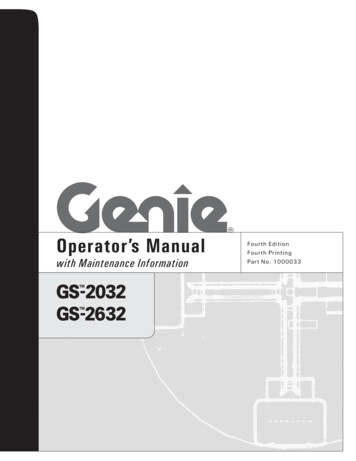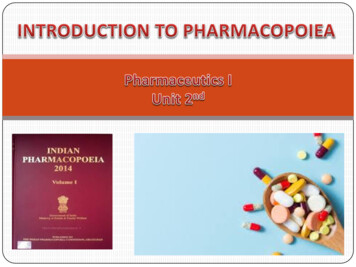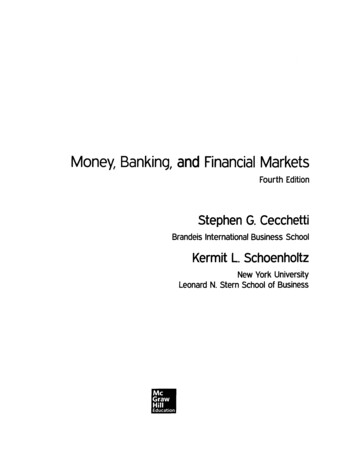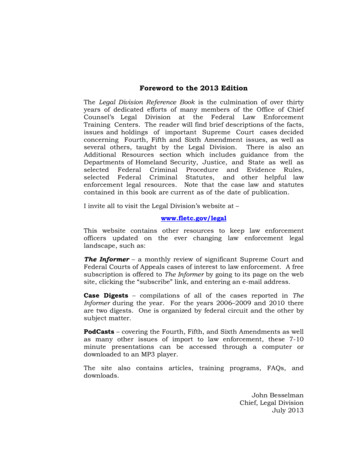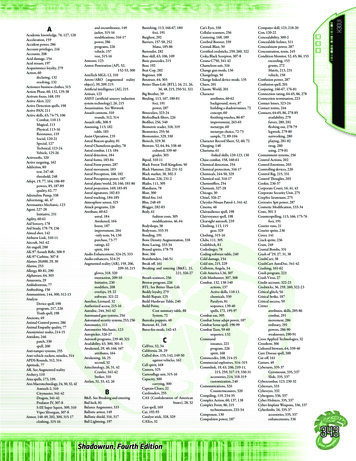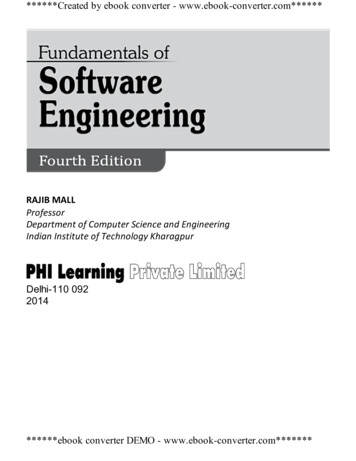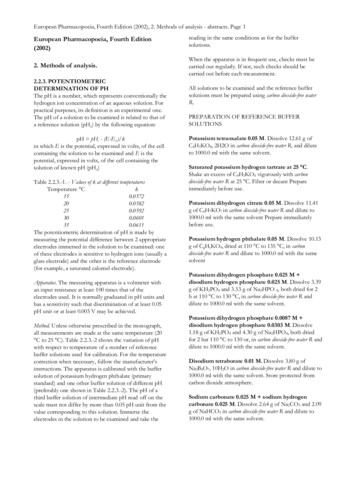
Transcription
European Pharmacopoeia, Fourth Edition (2002), 2. Methods of analysis - abstracts. Page 1European Pharmacopoeia, Fourth Edition(2002)reading in the same conditions as for the buffersolutions.2. Methods of analysis.When the apparatus is in frequent use, checks must becarried out regularly. If not, such checks should becarried out before each measurement.2.2.3. POTENTIOMETRICDETERMINATION OF PHThe pH is a number, which represents conventionally thehydrogen ion concentration of an aqueous solution. Forpractical purposes, its definition is an experimental one.The pH of a solution to be examined is related to that ofa reference solution (pHS) by the following equation:pH pHs - (E-ES )/kin which E is the potential, expressed in volts, of the cellcontaining the solution to be examined and E is thepotential, expressed in volts, of the cell containing thesolution of known pH (pHS)Table 2.2.3.-1. - Values of k at different temperaturesTemperature Ck150.0572200.0582250.0592300.0601350.0611The potentiometric determination of pH is made bymeasuring the potential difference between 2 appropriateelectrodes immersed in the solution to be examined: oneof these electrodes is sensitive to hydrogen ions (usually aglass electrode) and the other is the reference electrode(for example, a saturated calomel electrode).Apparatus. The measuring apparatus is a voltmeter withan input resistance at least 100 times that of theelectrodes used. It is normally graduated in pH units andhas a sensitivity such that discrimination of at least 0.05pH unit or at least 0.003 V may be achieved.Method. Unless otherwise prescribed in the monograph,all measurements are made at the same temperature (20 C to 25 C). Table 2.2.3.-2 shows the variation of pHwith respect to temperature of a number of referencebuffer solutions used for calibration. For the temperaturecorrection when necessary, follow the manufacturer'sinstructions. The apparatus is calibrated with the buffersolution of potassium hydrogen phthalate (primarystandard) and one other buffer solution of different pH(preferably one shown in Table 2.2.3.-2). The pH of athird buffer solution of intermediate pH read off on thescale must not differ by more than 0.05 pH unit from thevalue corresponding to this solution. Immerse theelectrodes in the solution to be examined and take theAll solutions to be examined and the reference buffersolutions must be prepared using carbon dioxide-free waterR.PREPARATION OF REFERENCE BUFFERSOLUTIONSPotassium tetraoxalate 0.05 M. Dissolve 12.61 g ofC4H3KO8, 2H2O in carbon dioxide-free water R, and diluteto 1000.0 ml with the same solvent.Saturated potassium hydrogen tartrate at 25 C.Shake an excess of C4H5KO6 vigorously with carbondioxide-free water R at 25 C. Filter or decant Prepareimmediately before use.Potassium dihydrogen citrate 0.05 M. Dissolve 11.41g of C6H7KO7 in carbon dioxide-free water R and dilute to1000.0 ml with the same solvent Prepare immediatelybefore use.Potassium hydrogen phthalate 0.05 M. Dissolve 10.13g of CgHsKO4, dried at 110 C to 135 C, in carbondioxide-free water R and dilute to 1000.0 ml with the samesolventPotassium dihydrogen phosphate 0.025 M disodium hydrogen phosphate 0.025 M. Dissolve 3.39g of KH2PO4 and 3.53 g of Na2HPO 4, both dried for 2h at 110 C to 130 C, in carbon dioxide-free water R anddilute to 1000.0 ml with the same solvent.Potassium dihydrogen phosphate 0.0087 M disodium hydrogen phosphate 0.0303 M. Dissolve1.18 g of KH2PO4 and 4.30 g of Na2HPO4, both driedfor 2 hat 110 C to 130 or, in carbon dioxide-free water R anddilute to 1000.0 ml with the same solvent.Disodium tetraborate 0.01 M. Dissolve 3.80 g ofNa2B4O7, 10H2O in carbon dioxide-free water R and dilute to1000.0 ml with the same solvent. Store protected fromcarbon dioxide atmosphere.Sodium carbonate 0.025 M sodium hydrogencarbonate 0.025 M. Dissolve 2.64 g of Na2CO3 and 2.09g of NaHCO3 in carbon dioxide-free water R and dilute to1000.0 ml with the same solvent.
European Pharmacopoeia, Fourth Edition (2002), 2. Methods of analysis - abstracts. Page 2Temperature C1520253035ΔpH(1)/ΔtPotassiumtetraoxalate0.05 MC4H3KO8,2H2O1.671.681.681.681.69 0.001Table 2.2.3.-2. - pH of reference buffer solutions at various gentartratecitratephthalatephosphatephosphate(Sat. 25 C)0.05 M0.05 M0.025 M0.0087 M 0.025 M0.0303 .783.773.76-0.00224.004.004.014.024.02 0.0012KH2PO4 Na2HPO46.906.886.876.856.84-0.0028KH2PO4 ate0.01 MSodiumcarbonate0.025 M sodiumbicarbonate0.025 MNa2B4O7,10 H2O9.289.239.189.149.10-0.0082Na2CO3 NaHCO310.1210.0610.019.979.93-0.0096(1) pH variation per degree Celsius.Page 24-252.2.32. LOSS ON DRYING2.4.9. IRONLoss on drying is the loss of mass expressed as per centm/m.Dissolve the prescribed quantity of the substance to beexamined in water R and dilute to 10 ml with the samesolvent or use 10 ml of the prescribed solution. Add 2 ma 200 g/l solution of citric acid Rand 0.1 ml of thioglyc acidR. Mix, make alkaline with ammonia R and dilute t 20 mlwith water R. Prepare a standard in the same man using10 ml of iron standard solution (1 ppm Fe) R.After 5 min, any pink colour in the test solution is not mintense than that in the standard.Method. Place the prescribed quantity of the substance tobe examined in a weighing bottle previously dried underthe conditions prescribed for the substance to beexamined. Dry the substance to constant mass or for theprescribed time by one of the following procedures.a) "in a desiccator": the drying is carried out overdiphosphorus pentoxide R at atmospheric pressure and atroom temperature;b) "in vacuo": the drying is carried out over diphosphoruspentoxide R, at a pressure of 1.5 kPa to 2.5 kPa at roomtemperature;c) "in vacuo within a specified temperature range": thedrying is carried out over diphosphorus pentoxide R, at apressure of 1.5 kPa to 2.5 kPa within the temperaturerange prescribed in the monograph;d) "in an oven within a specified temperature range": thedrying is carried out in an oven within the temperaturerange prescribed in the monograph;e) "under high vacuum": the drying is carried out overdiphosphorus pentoxide R at a pressure not exceeding 0.1kPa, at the temperature prescribed in the monograph.If other conditions are prescribed, the procedure to beused is described in full in the monograph.Page 482.4.14. SULPHATED ASHIgnite a platinum, porcelain or quartz crucible at 600 /50 C for 30 min, allow to cool in a desiccator over silicagel and weigh. Place the prescribed amount of thesubstance to be examined in the crucible and weigh.Moisten the substance to be examined with a smallamount of sulphuric acid R (usually 1 ml) and heat gently atas Iowa temperature as practicable until the sample isthoroughly charred.After cooling, moisten the residue with a small amountof sulphuric acid R, heat gently until white fumes are nolonger evolved and ignite at 600 /- 50 C until theresidue is completely incinerated. Ensure that flames arenot produced at any time during the procedure. Allowthe crucible to cool In a desiccator over silica gel, weighit again and calculate the mass of the residue.If the mass of the residue so obtained exceeds theprescribed limit, continue the ignition, as previously, toconstant mass, unless otherwise prescribed.Page 91
European Pharmacopoeia, Fourth Edition (2002), 2. Methods of analysis - abstracts. Page 22.5.9. DETERMINATION OF NITROGENBY SULPHURIC ACID DIGESTIONCalculate the content of sulphur dioxide in parts permillion from the expression: 128aSEMI-MICRO METHODa number of millilitres of a 0.1 M sodium hydroxidePlace a quantity of the substance to be examined (m g)containing about 2 mg of nitrogen in a combustion flask,add 4 g of a powdered mixture of 100 g of dipotassiumsulphate R, 5 g of copper sulphate Rand 2.5 g of selenium R,and three glass beads. Wash any adhering particles fromthe neck into the flask with 5 ml of sulphuric acid R,allowing it to run down the sides of the flask, and mix thecontents by rotation. Close the mouth of the flaskloosely, for example by means of a glass bulb with a shortstem, to avoid excessive loss of sulphuric acid. Heatgradually at first, then increase the temperature untilthere is vigorous boiling with condensation of sulphuricacid in the neck of the flask; precautions should betakento prevent the upper part of the flask from becomingoverheated. Continue the heating for 30 min, unlessotherwise prescribed. Cool, dissolve the solid material bycautiously adding to the mixture 25 ml of Water R, coolagain and place in a steam-distillation apparatus. Add 30ml of strong sodium hydroxide solution R and distilimmediately by passing steam through the mixture.Collect about 40 ml of distillate in 20.0 ml of 0.01 Mhydrochloric acid and enough water R to cover the tip of thecondenser. Towards the end of the distillation, lower thereceiver so that the tip of the condenser is above thesurface of the acid. Take precautions to prevent anywater on the outer surface of the condenser fromreaching the contents of the receiver. Titrate the distillatewith 0.01 M sodium hydroxide, using methyl red mixed solutionR as indicator (n1 ml of 0.01 M sodium hydroxide).Repeat the test using about 50 mg of glucose R in place ofthe substance to be examined (n2 ml of 0.01 M sodiumhydroxide).Content of nitrogen 0.01401 (n2 - nl) /m per centPage 1072.5.29. SULPHUR DIOXIDEIntroduce 150 ml of water R into the flask (A) (see Figure2.5.29.-1) and pass carbon dioxide R through the wholesystem for 15 min at a rate of 100 ml/min. Place 10 ml ofdilute hydrogen peroxide solution R neutralised with a 1 g/lsolution of bromophenol blue R in alcohol (20 per cent V /V)R in the test-tube (D). Without interrupting the stream ofcarbon dioxide. remove the funnel (8) and introducethrough the opening into the flask (A) 25.0 g of thesubstance to be examined with the aid of 100 ml of waterR. Add through the funnel 80 ml of dilute hydrochloric acidR and boil for 1 h. Open the tap of the funnel and stopthe flow of carbon dioxide and also the heating and thecooling water. Transfer the contents of the test-tube withthe aid of a little water R to a 200 ml wide-necked. conicalflask. Heat on a water-bath for 15 min and allow to cool.Add 0.1 ml of a 1 g/l solution of bromophenol blue R inalcohol (20 per cent V/V) R and titrate with 0.1 M sodiumhydroxide until the colour changes from yellow to violetblue.Figure 2.5.29.-1.- Apparatus for the determination of sulphurdioxide2.5.30. OXIDISING SUBSTANCESTransfer 4.0 g to a glass-stoppered, 125 ml conical flaskand add 50.0 ml of water R. Insert the stopper and swirlfor 5 min. Transfer to a glass-stoppered 50 ml centrifugetube and centrifuge. Transfer 30.0 ml of the clearsupernatant liquid to a glass-stoppered 125 ml conicalflask. Add 1 ml of glacial acetic acid R and 0.5 g to 1.0 g ofpotassium iodide R. Insert the stopper, swirl, and allow tostand for 25 min to 30 min in the dark. Add 1 ml of starchsolution R and titrate with 0.002 M sodium thiosulphate untilthe starch-iodine colour disappears. Carry out a blankdetermination. Not more than 1.4 ml of 0.002 M sodiumthiosulphate is required (0.002 per cent, calculated as H2O).1 ml of 0.002 M sodium thiosulphate is equivalent to 34 μgof oxidising substances, calculated as hydrogen peroxide.Page 114
European Pharmacopoeia, Fourth Edition (2002), 2. Methods of analysis - abstracts. Page 32.6.12. MICROBIOLOGICAL EXAMINATION OFNON-STERILE PRODUCTS (TOTAL VIABLEAEROBIC COUNT)The tests described hereafter will allow quantitativeenumeration of mesophilic bacteria and fungi, which maygrow under aerobic conditions.The tests are designed primarily to determine whetheror not a substance that is the subject of a monograph inthe Pharmacopoeia complies with the microbiologicalrequirements specified in the monograph in question.When used for such purposes follow the instructionsgiven below, including the number of samples to betaken and interpret the results as stated below. The testsmay also be used for the test for Efficacy of antimicrobialpreservation (5.1.3) as described in the Pharmacopoeia.They may furthermore be used for monitoring rawmaterial quality and may be used in association withguidelines on Microbiological quality of pharmaceuticalpreparations (5.1.4). When used for such purposes, forexample by a manufacturer for raw materials and/orfinished product monitoring or for process validation,the conduct of the tests including the number of samplesto be taken and the interpretation of the results arematters for agreement between the manufacturer and thecompetent authority.Carry out the determination under conditions designed toavoid accidental contamination of the product to beexamined. The precautions taken to avoid contaminationmust be such that they do not affect any microorganisms,which are revealed in the test. If the product to beexamined has antimicrobial activity this must beadequately neutralised. If inactivators are used for thispurpose their efficacy and non-toxicity versusmicroorganisms are demonstrated.Determine the total viable aerobic count by themembrane filtration method, or the plate-count methodas prescribed in the monograph.The Most Probable Number (MPN) method is reservedfor bacterial counts when no other method is available.The choice of a method may be based on factors such asthe nature of the product and the expected number ofmicroorganisms. Any method, which is chosen, must beproperly validated.When used in conjunction with chapter 5.1.3 or 5.1.4, thepour-plate method, the surface-spread method and themembrane filtration method may be used.PREPARATION OF THE SAMPLESampling plan. Sampling of the product must follow awell-defined sampling plan. The sampling plan will bedependent on
European Pharmacopoeia, Fourth Edition (2002), 2. Methods of analysis - abstracts. Page 2 Table 2.2.3.-2. - pH of reference buffer solutions at various temperatures Temperature C Potassium tetraoxalate 0.05 M Potassium hydrogen tartrate (Sat. 25 C) Potassium dihydrogen citrate 0.05 M Potassium hydrogen phthalate 0.05 M Potassium dihydrogen
